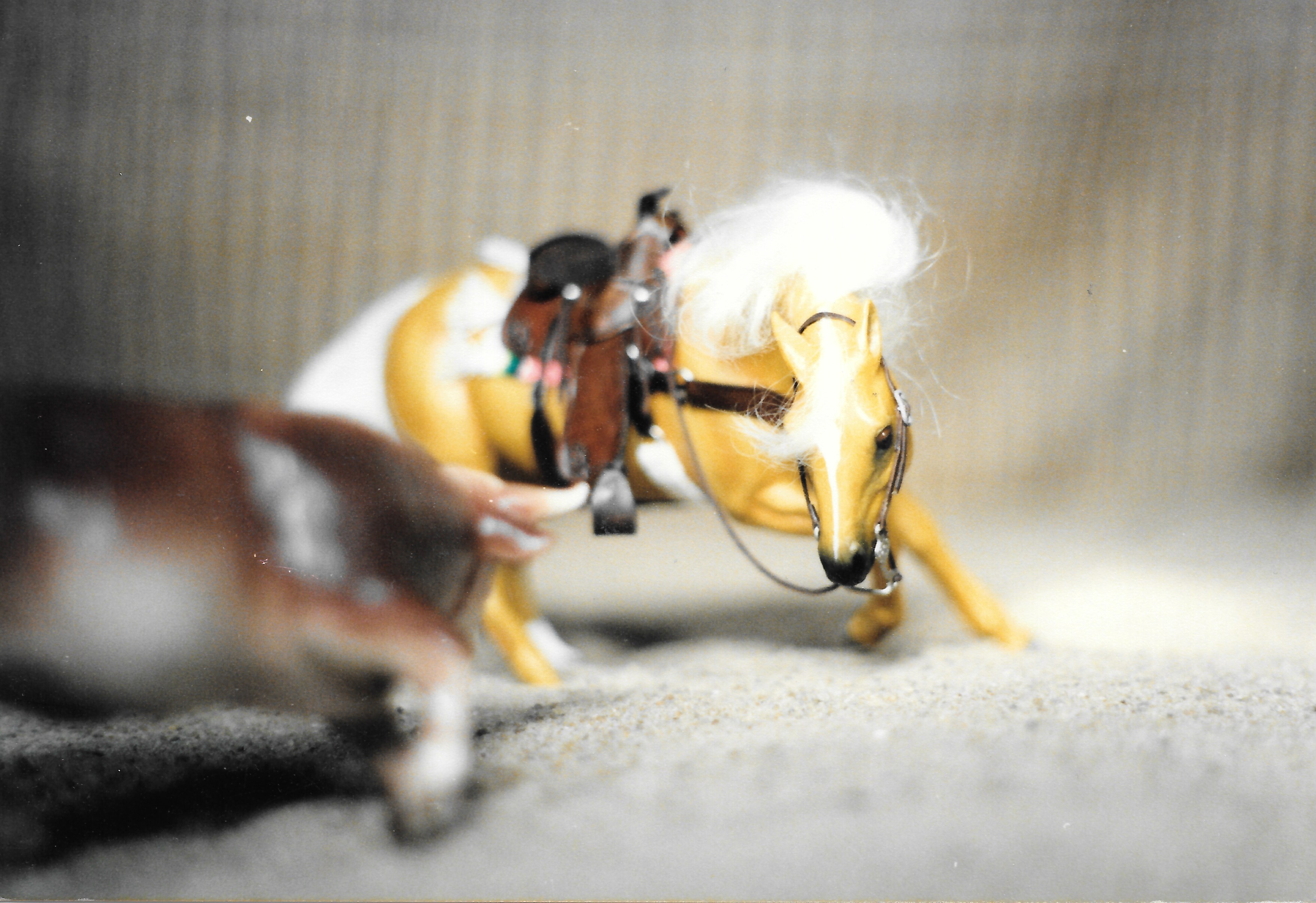These are pictures from a 1984 California backyard live model horse Show that was held by Kristin Chernoff to benefit the LAPD Mounted Police Unit. Wow, we’ve sure come a long way since then! This was one of two, maybe three shows held each year in Southern California. I was 14, and it was my third year of live showing. For now, the images are the small scans I made ages ago, when bandwidth was tighter. I’ll try to replace them with fresh scans as I am able.
In the early eighties, most live shows started with the Big 5 Gender classes: Stallion, Mare, Gelding, Colt, and Filly. (Sometimes Colt and Filly were combined, especially since most Breyer foal molds are fillies.) You entered your 5 best horses in this class. You see the results: bumper-to-bumper model horses. Now you know why we used string back then, to select out the top 15 or so for further judging!
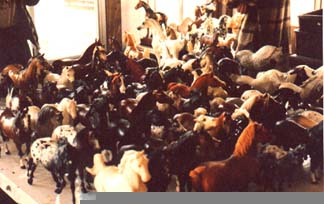
There were no divisions for custom, china, resin, or plastic. Nosirree, we just plunked 'em all on the table together, in a happy melange. In this photo of the Stallions class, you can pick out an H-R Nataf (they were current then!), an H-R Metalchex, glossy Alabaster and Palomino 5-Gaiters, a gray Eustis drafter, a Beswick leopard appaloosa, an OF chestnut Belgian, and PASs of all sorts: OF, repaint, repaint/hair, and flocked! The PAS was very popular at live shows, since he represented a majestic Arabian stallion (!). On the left, you can see a fairly nice black appaloosa repaint on a Running Stallion. And in front of the Belgian, about to be crushed by his raised foreleg, is an OF Little Bit Arabian stallion! Judge didn’t get much of a chance to see him. These classes could frequently approach 100 models.
Once the judge ‘strung’ about 15, the rest of the class would be excused. Then the judge would place the remaining models. She would arrange them in a neat line, first through HM. (Now, the custom is not to touch models without the owner’s permission.) A lot of these models were china, too.

This was the Mares class, and note that the judge has picked chinas, remakes, and OF plastic all together out of a very large class. The winner is a small Zara; second is a PAM remade by Kathy Maestas. Then after that is an old mold bay PAM, then a repainted Running Mare, then a woodgrain running mare, then an alabaster Hartland Polo Pony.
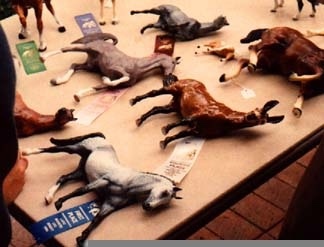
Gelding classes were always a lot smaller, since everyone wanted their horse to be an important prize-winning stallion! Nevertheless, the winner of the gelding class, a Keen repainted dapple grey by Jason Ross (Nancy Strowger), could probably still compete well today.
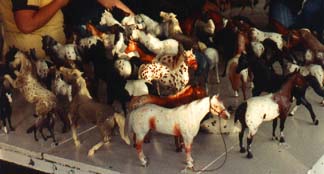
Hope you like spots! You won’t be surprised that this is the Appaloosa class. All the finishes are still mixed together - you’ll see repaints, drastic remakes, and some neat old OFs all competing together on this table. The chestnut leopard Stud Spider in the foreground was one of my early repaints. (He’s a little less orange in the actual picture.) Also competing is my OF grey appaloosa Hartland foal (right in front of the Smoke Mustang).
At the end of the day, there would be separate finish classes, like “Hagen-Renaker,” “Repaint only,” “Repaint/Hair,” “RRH,” “Hartland,” and the ever popular “OF Breyer.”
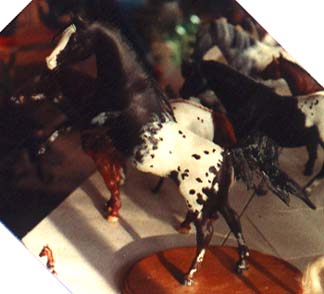
A closeup on the Appaloosa class – a drastic custom from an Indian Pony with a string mane and tail. (Sorry, I’ve forgotten the artist. Anyone know?)
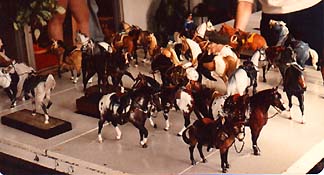
Time for the Western Pleasure class. You can see that there was a lot of variation in what people would show in WP – there’s the nice calm trotting appaloosa in the foreground, but check out the park trotting Eustis Arab, the OF Running Stallion, the OF Western Horse, and the Wedgewood Mustang! There was a lot of incentive to show your horse in absolutely everything, to accumulate points towards Grand Champion.
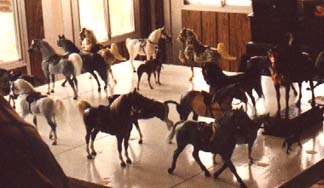
The Huntseat class was a lot like WP – take whatever horse you’ve got, and put some Huntseat tack on it! I think that’s a Copenhagen Five-Gaiter in the background. And, lots of Proud Arabian Stallions.
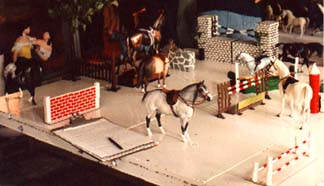
My favorite class was definitely the Hunter/Jumper, aka Jumping Demolition Derby class. The big bronze horse on the base is supposed to be jumping that little gray block in front of him. And, yes, that roan Adios is supposed to be jumping that big wall. I think he ended up with a good ribbon, too. The Adios closest to the camera did well, too…he’s in the next picture!
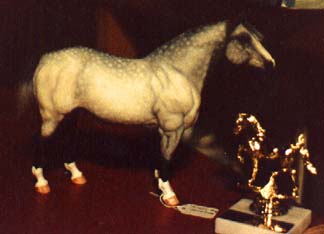
At the end of the day, this guy was the Overall Grand Champion (which included halter and performance). He was a repainted and haired Adios created and owned by Carla Clifford. He’s prettier than he appears - the yellowish cast is from the low light, since by now it was dark outside. There’s a good shot of him in the H/J picture above, and you’ll see him in WP as well. (R/H Adios’es were all the rage! They showed well in everything, even in all sorts of performance classes.)
Thank you for that post! I like learning things about early days of model horse hobby, so every piece of info is precious to me.
(Finally managed to join Ponydom and regret not doing it earlier)
I was asked in another space about what I meant when I talked about string. Literally, a judge would place a maybe 1 foot (25cm) long piece of string or yarn over the top 15 or so models they were interested in placing, and ask for the others to be removed, so that the top horses would have more room for a close examination. The string might also be placed near or under the horse if a string over the back was problematic. Some shows have also used pennies or another marker, generally a marker you’re not meant to keep.
If you look at the classes in the post, the whole table is filled to the center and there’s no way to closely examine the center models for flaws or to really appreciate them. Removing the extra horses meant all the contenders could be seen and considered. This was especially important in spaces that aren’t aggressively lit.
Today we rarely tolerate models having to be in the center of a table at all, and we use oblong 8’ card tables in larger spaces. We also split classes much more aggressively - and no one offers a “stallions” class any more that would attract so many entrants.
I remember how showing in all the classes was so important. My first live show was in 1990 and I had a customized Stablemate Morgan Mare. She took the overall Grand for the show even though she only showed in halter. The judge explained that she was so exceptional, especially given that she was a Stablemate, that she deserved the win. I don’t think I’ve ever been more thrilled with a championship.

